Insect Management
Many insects live and feed in grass. Most are harmless, some are beneficial, and some are pests. There are only a few that cause significant damage and need control. Insects are only one of the many potential causes of brown, thin, or dead grass. Drought, disease, nematodes, and nutritional deficiencies can also cause lawn damage. Healthy lawns are generally less susceptible to pests and can recover faster. Americhem offers programs to control lawn damaging as well as nuisance pests in your home lawn.
Fire Ants
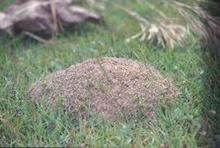
Imported fire ants are small, aggressive ants that build rounded nests or mounds that can be as large as two or three feet across. Imported fire ants occur throughout Florida, infesting over 30 million acres. Their mounds can disrupt mowing, impede your ability to thoroughly enjoy your yard, and damage electrical equipment. Fire ants don’t inflict direct feeding damage on lawns but their mounds are an aesthetic issue and public health concern. They also account for trips to the emergency room as their bites have been known to cause severe swelling and intense allergic reactions. The young and elderly are especially vulnerable to allergic reactions to the painful bites fire ants inflict. Fire ants aggressively defend their colony and inflict painful bites and stings to people and pets. Americhem offers a once a year proven fire ant prevention treatment so you can rest easy and enjoy a fire ant free yard all year long. Call us for your free evaluation and estimate.
Southern Chinch Bug
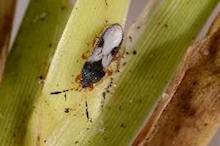
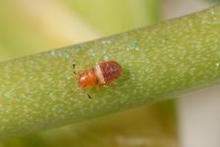
The southern chinch bug is the most important pest of St. Augustine grass in Indian River County, the most commonly planted grass in our area. Chinch bug adults are about 5 mm (0.2 in) long and black with white patches on their wings, which are folded over the back. Young nymphs are reddish-orange with a white band across the back. Body color darkens and becomes black as nymphs become adults.
Chinch bugs feed on St. Augustinegrass at the crown or stem, near the soil surface. Visual lawn damage tends to be concentrated and spread outward. Injured lawns look stunted, yellowed, wilted, or dead. Yellow to burnt-brown patches are often first noticed along sidewalks, in poorly irrigated areas, or full sun locations of your lawn. Drought conditions are also commonly mistaken as chinch bug damage. Americhem can help identify if your lawn is suffering from drought or chinch bug damage. Call us today for a free assessment of your property.
Tropical Sod Webworm
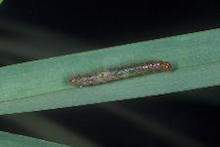
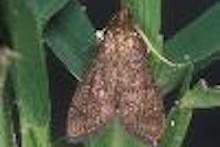
Tropical sod webworm is a sporadically damaging caterpillar pest of most warm season grasses including St. Augustine grass. Larvae are gray-green, have brown spots on each segment, and a light brown head. Mature larvae can be about 0.75–1 inch in length. Sod webworms form cocoons in the soil. .Sod webworm adults are small, tan to gray moths with a wingspan of 19 to 25 mm (0.75–1 in). The moths hide in shrubs and other sheltered areas during the day and begin flying at dusk. Newly hatched sod webworms remain curled up in the soil during the day and feed at night. Damage begins in small patches of brown, short-clipped grass, about 2.5 to 7.5 mm (0.1–0.3 in.) in diameter. Small, green droppings can be seen on the ground surface. Sod webworms chew notches in the leaves which causes the grass to look ragged or irregularly shaped. Sod webworms can be especially damaging to close-cut turf, but rarely cause lasting damage to high-cut turf. Sod webworms are most active from April through November. Larger populations of sod webworms can attract birds, which may cause additional damage because the birds will tear up the grass searching for caterpillars.
White Grubs
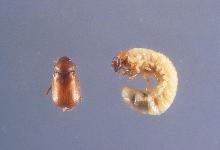
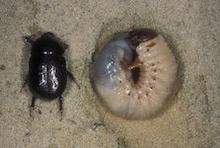
White grubs are another sporadic problem of grass in Florida. However, certain species can be very damaging in coastal regions. The masked chafers are most frequently encountered, and Tomarus subtropicus are the second most common.

